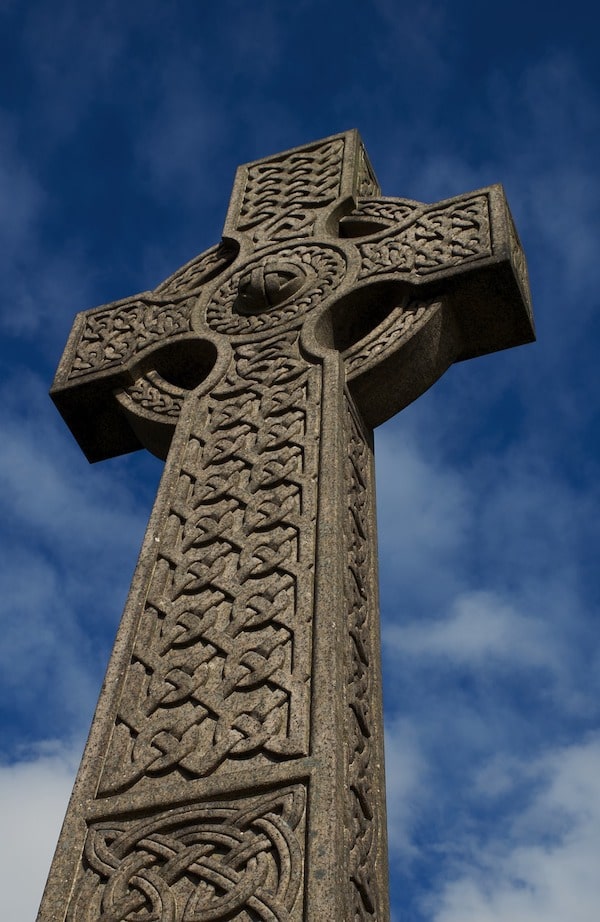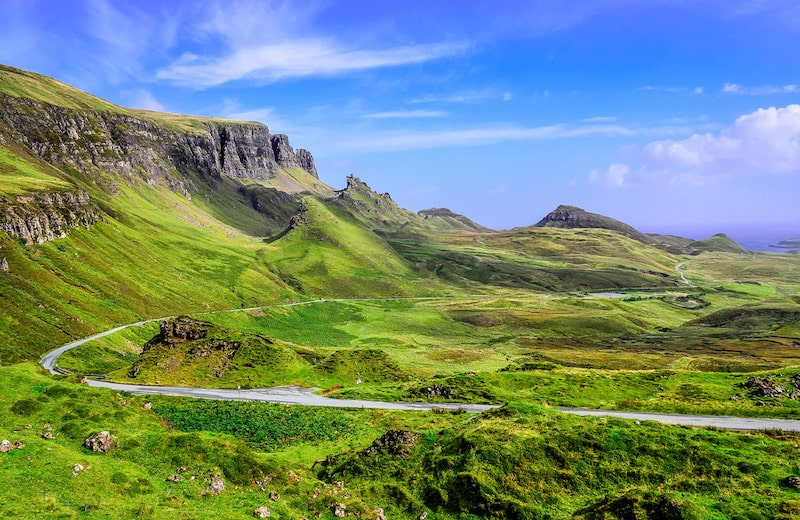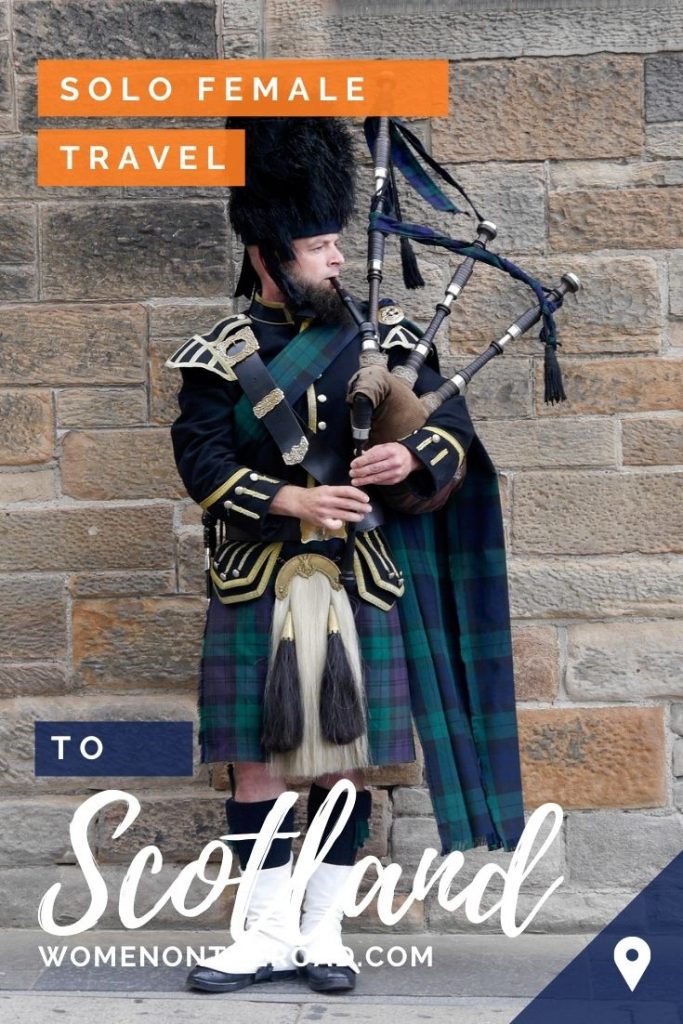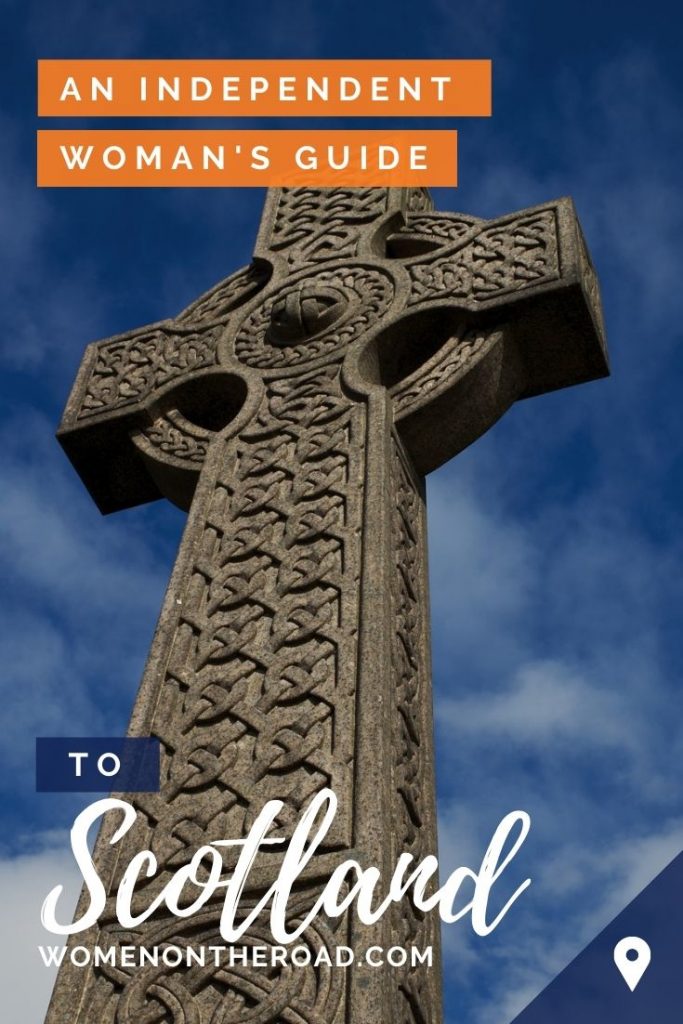This quick guide on solo travel to Scotland is all about seeing what Scotland has to offer, especially if you happen to be a solo traveler over 50. We look at it all, from big cities and folk festivals to mysterious lakes and breathtaking wilderness.
Ah, Bonnie Scotland. Famous for whisky, tartan, Nessie the Loch Ness monster, Harry Potter, men in kilts and Braveheart (so, basically men in kilts again). And you can go it alone: solo travel to Scotland should be smooth sailing.

One of the best things about Scotland is how easy it is to explore. Even a few days can give you a strong sense of the country, whether you’re on a road trip or using its picturesque rail network.
This is not an in-depth guide but a quick snapshot of Scotland for those of you who know very little about this welcoming country and who are contemplating their first trip to Scotland.
NOTES FROM THE EDITOR
For those of you who are consistently confused about Scotland’s status, let’s clear this up: Great Britain is an island, and Scotland, along with England and Wales, is part of Great Britain. It is also part of the United Kingdom, which includes the three nations of Great Britain plus Northern Ireland.
Scotland is a country and was a sovereign state until the early 18th century. While some of its affairs are run by London, it has its own Parliament and a significant degree of autonomy. In 2014, 55% of Scots voted against independence. In November 2022, the Supreme Court ruled against the Scottish Parliament’s proposal to hold a second referendum.
It is a rugged, beautiful country, whose harsh climate helped give birth to great thinkers and writers. And while Scots may have a reputation for being close to their pennies, you’ll rarely find a friendlier or more hospitable nation.
The problem with Scotland is that there is so much to see, all of it beautiful. The good thing is that the country, because of its huge sea inlets, isn’t that wide so getting from one place to another takes less time than you might think.
Best places for a solo trip to Scotland
Here’s a peek at places that are perfect for a solo Scotland trip.
There’s every chance you’ll start your Scottish trip in a city, whether you’re arriving by train or by plane.
Edinburgh
The capital, Edinburgh, is the country’s literary heartland, the first-ever UNESCO City of Literature. In fact both its Old and New Towns are on UNESCO’s World Heritage List. It’s the perfect jumping-off point for a Scotland trip.
There are plenty of attractions, like the Old Town, with its buildings dating back centuries, and its historical pubs and eclectic shops.
The Royal Mile stretches from Edinburgh Castle to the Palace of Holyroodhouse, and is home to a number of sights you’ll want to visit, from Parliaments and the Courts to churches and cathedrals.
On the hill overlooking it all is Edinburgh Castle, one of the city’s most popular sights, a military stronghold where kings and queens lived for centuries.
To visit Edinburgh, you can wander on your own and follow this one-day literary itinerary, or take one of the many thematic tours Edinburgh offers – Sherlock Holmes, Harry Potter, Underground Vaults… Or why not a free walking tour, the kind that doesn’t charge you anything but leaves the tip up to you?

Glasgow
Scotland’s largest city isn’t the capital, though – that honor is reserved for Glasgow, an hour’s train ride away. The city has a thriving arts scene and great music venues, with plenty of great food and much to do. The two largest cities in Scotland are quite complementary.
Stop by George Square to admire statues dedicated to famous Scots, including of course Robert Burns, but also Sir Robert Peel and Sir Walter Scott.
The town surrounds Glasgow Cathedral, which is both huge and well worth seeing. It’s free to visit but get a ticket ahead of time to make sure you can get in.
There are plenty of other cities, of course, such as Dundee and Aberdeen on the East Coast or Inverness on the North Coast, the jumping-off point for Loch Ness, where you too can take a stab at sighting the legendary monster! (If you’re not headed there, you can still visit Loch Ness on a day trip from Edinburgh.)
The Scottish countryside
Scotland is known for its stunning natural beauty, from the Highlands to the jagged seashores to the nearly 800 islands that dot its coastline. It is a paradise for hikers, climbers, birdwatchers and nature lovers of all types.
The Isle of Skye is probably the most visited, and the Orkney Islands are for lovers of prehistoric sites. From Orkney in summer you could catch a ferry to John O’Groats, a bit touristy perhaps, famous as the finishing line (or starting line!) of the Great British Walk that starts at Land’s End some 1500km (874 mi) away.
Scotland has two national parks: Trossachs National Park, which includes the stunning Loch Lomond, and the Cairngorms National Park, the country’s largest.
For more on what to see, here’s a good Scotland guidebook.


Scotland’s many festivals
Clearly the Scots love a good time and Scotland is famous for its festivals. Barely a week goes by without a major celebration taking place in some part of the country, and here are some of the best known:
Edinburgh in August
This is festival prime time and some of the most famous include the Edinburgh Festival Fringe, the Military Tattoo and the international festivals of jazz, books and art. If you can make it here in August, you’ll get an overdose of culture. Of course you’ll also pay premium prices for accommodation!
Hogmanay (New Year’s Eve)
Like many countries, the Scots celebrate the New Year with fireworks and by singing Auld Lang Syne, but there is also another tradition: being ‘first foot’ over each other’s threshold to welcome in the New Year, something which harks back to Viking times.
Burns Night
And while you’re singing Auld Lang Syne, you might consider the poet Robert Burns, whose authorship of the song is only one of his many claims to fame.
The unveiling of his statue in the heart of Glasgow attracted 30,000 people.
He is so revered in Scotland that he has his own national day, 15 January. Burns Night is a great time to experience some Scottish traditions firsthand, as many places organize ‘Burns Night dinners’ with food and traditional dancing.
Highland Games
If you like competition and men in kilts, head to one of these. The games usually take place on weekends throughout the summer and are held in a range of locations. Sports include favourites such as the caber toss (throwing a log − yes, for real), hammer throwing, running and tug of war.
The games will also include bagpipes, traditional dancing, live music, tartan and whisky. The most famous is the Braemar Gathering, which is held in the Cairngorms National Park on the first weekend in September. Members of the British Royal Family can usually be found enjoying the spectacle.

Beyond festivals: other Scottish experiences
Festivals are wonderful but there is plenty more to enjoy.
- You cannot visit Scotland without stopping at a whisky distillery. There are over 100 to choose from, and the popular ones do get booked up well in advance so if you have a favourite, reserve your space quickly.
- If you can, you should also wrangle an invite to a Scottish traditional dance. There are four different types of traditional dancing in Scotland: ceilidh, country, Highland and step dancing. All of them are great fun to watch but a ceilidh is a group dance, very traditional at weddings and is a brilliant way to spend an evening if you want to get involved. Don’t worry − everyone gets it wrong at some point; the idea is to join in and have fun.
- Scotland is also the land of the bagpipes and if you’re lucky you’ll get to hear them whilst you’re there. Many of the historical venues employ a bagpiper to open or close the monument each day. Edinburgh Castle is famous for theirs and can be heard right down in the city centre.

Best time to visit Scotland
Choosing the best time to visit Scotland will depend entirely on what you’re hoping to do while you’re there.
If you want to explore the outdoors and enjoy hiking, outdoor sports, birdwatching or wildlife photography, anytime between April and October gives you a chance of better weather − although this is never guaranteed in Scotland!
The Edinburgh Festival Fringe is, of course, in summer (more on that in a moment).
If you want to ski, snow is most likely between January-March, but you can get lucky outside of these times. Scotland has the only proper ski resorts in the UK, so expect them to be busy.
If you want to party, Hogmanay (New Year’s Eve) is the time to visit. The entire country becomes one giant celebration and you’ll feel the warmth and friendliness of the Scots wherever you go.
Beware of the midges
Bear in mind, summer is peak midge season, especially on the West Coast, which can make being outdoors miserable.
If you’ve never heard of ‘midges’, they are tiny mosquitoes with a nasty bite. They swarm around water, especially stagnant water like lakes and ponds. Sitting outside near them is almost impossible and you’ll see plenty of people wearing hats with netting (a little like a beekeeper) to keep the ‘blighters’ at bay.
Getting around Scotland
If you’re staying in one of the big cities like Edinburgh or Glasgow, you can get around just fine by public transport.
However, if you want to go off into the Highlands, visit John o’Groats or drive the NC500, you’ll be much better off with your own transport.
Is it easy to travel Scotland without a car?
A car is the best option but if you’re feeling particularly adventurous, why not go motorcycle touring in Scotland? The country has some of the best driving roads in the UK, and there are so many places to stop and admire the beautiful scenery. Bear in mind, though, that driving in Scotland is on the left, unlike North America.
If you can’t get your own vehicle, it is possible to travel between towns and cities by train, many of which enjoy the most incredible views along their route. You can check the schedules here.
If you’re planning to ride the ‘Hogwarts Express’ train, which runs from Fort William to Mallaig and is actually called the “Jacobite”, you’ll need to book well in advance as tickets sell out quickly.
Even if you have your own vehicle, this train ride is worth taking, as you see some of the most incredible places in Scotland. It was named one of the best train journeys in the world by Condé Nast.
You can also fly into one of the Scotland airports – Aberdeen, Edinburgh, Glasgow or Inverness.
Is Scotland safe for solo female travelers?
As an English speaker (or even if you’re not), Scotland is one of the best places for a woman to travel alone.
Apart from the fact that the Scots speak English (even if the accent can be difficult to understand at times), you’ll find things like public transport and the lifestyle much like anywhere else in Europe, different enough to be interesting but similar enough to be relatively familiar.
Of course there are some places where you shouldn’t venture out alone, especially after dark. Glasgow has a poor reputation but major cities anywhere in the world have their less-than-desirable neighborhoods.
Even hiking in the Scottish Highlands is considered safe for solo holidays, as long as you tell someone where you’re headed. Some areas can be so remote you won’t even get a phone signal.
Eating Scottish food
Scotland is famous for its incredibly fresh fish and seafood – Scottish salmon, anyone? It also has slightly quirkier fare and local specialties, like these:
- Haggis, which is Scotland’s national dish. Haggis is actually banned in the US due to the use of sheep lungs.
- Neeps: turnips
- Tatties: potatoes
- Black pudding: pork or beef blood, mixed with fat and a type of cereal, like oatmeal
- Scotch broth: a bouillon-like soup with meat and vegetables
- Butteries or butty: bread roll
- Cullen Skink: thick creamy soup with seafood or fish, reminiscent of chowder
- Shortbread: sweet buttery biscuits which make a great gift for loved ones back home.
Where to stay in Scotland?
Scottish people are famous for their hospitality. Wherever you choose to stay, you’ll be greeted with a friendly smile and made to feel very welcome.
You’ll find the entire range of accommodations in Scotland, from the most luxurious hotels to cozy bed and breakfasts.
Hotels in major cities can be expensive, especially in Edinburgh, and prices can almost double over New Year and during the festivals. If you’re visiting during those times, you might prefer to stay just outside the city and take public transport in.
But outside these cities, prices are fairly reasonable and in line with the rest of the UK.
Here are a few hotel recommendations for Edinburgh:
Budget: Old Waverley Hotel (many rooms have incredible views of Edinburgh Castle)
Mid-Range: The Bonham (every room has a city view)
Luxury: Balmoral Hotel (with a Michelin starred restaurant)
Otherwise, have a look at this accommodations map to find suitably priced rooms throughout the country:
Additional Scotland travel tips
Before you visit, here are some more things you should know about solo travel to Scotland.
- The Scots have a (mostly) friendly rivalry with the English, but there’s a lot of truth in the fact that they want ‘anyone but England’ to win at any competition. They also hate to be confused with the English; remember, Scotland and England are separate countries, even though both are part of the United Kingdom and Great Britain.
- Football (soccer) is the national sport and rivalries can be very heated, especially in cities that have two clubs, like Glasgow. This is a good time to give pubs a wide berth!
- The national language of Scotland is Scottish Gaelic, but most people speak English.
- Scotland uses British pounds and it doesn’t matter whether your bank notes say Bank of England or Bank of Scotland. Both are legal tender.
- Tips are generally not included -10% is standard and much appreciated.
- Bring a coat or umbrella. Everywhere. At all times. And maybe waterproof clothing.
- Even if you don’t drink alcohol, a distillery or whisky tour should be a part of your visit – the technology and the long history behind whisky distilling are big parts of Scottish culture.
- ‘Loch’ is pronounced ‘lock’ but with a bit of a growl at the end.
- Sip your whisky − don’t shoot it. Also, it’s called ‘whisky’ in a bar, not Scotch.
Solo travel to Scotland – final thoughts
If you’re a solo female traveler over 50, you’ll find Scotland safe for adventuring. There is a lot to take in, both in urban and rural parts of the country. From landscapes and wild nature, to museums and libraries, along with outgoing people, great local food, song and dance, and of course, plenty of drinks.
I hope that all this helps you have an amazing trip to Scotland – you won’t regret it.
* * * * *
Guest Contribution by Kathryn Bird. She never planned to get her own motorcycle, quit her job and set off to visit 17 countries and drive nearly 30,000 miles (not including the times she was lost). Read more at bikergirllife.com, and follow her on social media on YouTube, Instagram or Facebook.



